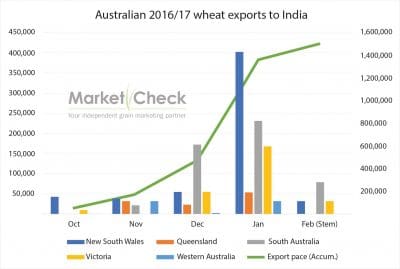INDIAN demand for Australian wheat is set to withstand supply-side pressure from its own crop now being harvested, and an import tariff which the Indian Government is expected to reintroduce by early April.
That’s the opinion of trade sources, who expect the Indian Government to reinstate a tariff on imported wheat to encourage local buying of the Indian wheat crop estimated at more than 90 million tonnes (Mt).
“Even if Australian wheat incurred a 10 per cent import tax into India, we would still be competitive on ASW,” Market Check head of advisory, Richard Perkins, said.
In recent years, India has been a market of generally insignificant volume for Australian wheat exports, but since October last year, it has imported 1.5Mt of Australian wheat to help compensate for a shortfall in domestic production.

India’s wheat imports from Australia were 1.5Mt by February (green line, right axis cumulative total) since the start of the marketing year in October; the shipment quantities by month from each state are shown (bar chart, left axis). (Source : Market Check)
The USDA Foreign Agricultural Service March report lifted the 2016-17 (July-Jun) estimate for Indian wheat imports from all origins to 5.5Mt, up from the February estimate of 3.7Mt, and a total of 300,000t imported in 2015-16.
Trade sources say much of that tonnage has already been bought, with Ukraine the supplier of up to 3Mt when India temporarily relaxed its requirement for methyl bromide fumigation last year, a move which has since been reversed.
“India requires methyl bromide fumigation at origin, which excludes Russian wheat from participating, and Ukraine’s key wheat export window doesn’t kick off until August,” Mr Perkins said.
That puts Australia in the box seat as a supplier to India until August at least, and beyond if the fumigation-at-origin requirement stands.
Buying interest is expected to rekindle in May or even April, when the trade has a handle on the size of the Indian crop and the import duty.
Get our free daily cropping news straight to your inbox – Click here
“They might take another 1 or 2Mt of old-crop because Australia is the only exporter that can fumigate at origin with methyl bromide,” one trader said.
In the past nine months, India’s tariff on wheat has been set at 15pc and 10pc before dropping to zero in December in response to dwindling domestic stocks.
Traders expect a similar scenario may play out this year.
Favoured in the south
AGT Foods Australia CEO, Peter Wilson, said while plenty of wheat is being harvested in India’s wheat-producing northern states, Australian wheat remains competitive in the country’s south.
“It’s still going into ports which would have to drag it from north to south in India at a greater cost than they have to pay to import directly from Australia,” Mr Wilson said.
As wheat in India is primarily used to produce flat breads, ASW and APW of around 9-10.5 per cent protein are the preferred grades.
“Most buyers are looking for a sound milling wheat, but there is some demand from people wanting to make volume loaves that require flour from higher-protein wheats.
Supporting ASW values
Mr Perkins said the ASW discount to APW across the east coast of Australia has halved, rallying $15 since the end of January, with Indian demand being a major supporting factor.
To illustrate this, GrainCorp’s highest bids at Condobolin in the Port Kembla zone today for APW1 and ASW1 stand at $190.50/t and $174.50/t respectively, compared with values on January 23 of $182/t and $153/t.



HAVE YOUR SAY